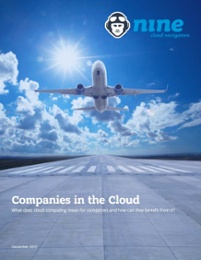While many of the world's small and medium businesses have made the transition to the
cloud, there are a number of holdouts that continue to run all of their digital services from
in-house servers or traditional data centers. Perhaps your company is one of them. Maybe
you haven't migrated to the cloud because you fear that doing so would increase your IT
costs. Perhaps you believe that a cloud migration would result in your company losing
control over its most critical data. The truth, though, is that moving to the cloud doesn't
result in a loss of control - and you'll likely save money in the process. Is a cloud computing
myth keeping your company from completing its digital transformation?
We are going to expose some of the most common cloud myths
Myth 1: «Cloud Computing Costs Too Much for Small Businesses.»
Virtually every major corporation that offers digital services has moved at least a portion of
those services to the cloud. You might assume, therefore, that migrating to the cloud is
outside the budget of a small business.
In a sense, though, the cloud actually represents the democratization of computing resources. When your company utilizes a cloud service, you only pay for the resources that you use.
Myth 2: «Cloud Computing Is Another Tech Fad That'll Disappear Tomorrow.»
The cloud isn't new, and it isn't a passing fad. Among consumers, in fact, the traditional
personal computer has already become nearly irrelevant. When people access services such
as Gmail, YouTube and Netflix, they're harnessing the computing power of remote cloud
servers.
The same will happen to businesses. Within a few years, most of your employees
will no longer need standard workstations. Instead, they'll use terminals with Internet
connections to access cloud-based services running on remote hardware. The transition will
likely slash your company's IT hardware budget - and your office's power consumption.
Myth 3: «A Cloud Environment Isn't as Secure as a Server My Company Controls.»
Running your own server is comfortable and familiar. It is not, however, more secure than a
cloud environment. It is the full-time job of cloud management staff to apply the latest
patches promptly, monitor for unusual network activity and keep hackers out. Unless you
disconnect your company's internal network from the Internet, it can't be as secure as a
cloud environment.
Myth 4: «Cloud Providers Don't Understand My Industry's Compliance Challenges.»
Cloud providers serve companies in every industry that you can imagine. A good cloud
service provider knows how to help your company comply with the data protection
standards for every industry and region. Because of the high security standards that cloud
providers have in place to keep their data centers secure, simply moving your operations to
the cloud may help your company comply with certain data protection regulations.
Myth 5: «Migrating to the Cloud Will Increase My Company's IT Costs.»
Migrating to the cloud allows your existing IT staff to focus less on security and maintenance and more on activities that drive revenue. Moving to the cloud therefore has the potential to increase the ROI of your IT expenses. Utilizing cloud services can also enable your company to grow without hiring additional IT staff.
Myth 6: «Migrating to the Cloud Is an "All or Nothing" Proposition.»
It is possible to migrate some services to the cloud while continuing to run other services
from your company's own servers. Adopting a hybrid cloud strategy is a great way to utilize
the power and scalability of the cloud without losing a legacy service or an application that
requires direct access to server hardware.
Many of the applications that your company uses are likely available as cloud-based applications. If you have an application with no cloud-based equivalent, though, you can continue using it as you currently do while moving your other services to the cloud.
Myth 7: «The Cloud Isn't a Mature Technology.»
The cloud isn't a technology that's still in the process of emerging -- it's a technology that's
here now, and it's the primary focus of most of the companies that develop enterprise
software applications. Microsoft, IBM, Oracle, Amazon, HP and Google - among many other
companies - have staked their futures on cloud-based infrastructure and applications.
Cloud-based applications are mature, secure and ready to meet your company's needs.
Myth 8: «My It Personnel Can't Handle Cloud Management.»
When your company transitions to the cloud, you'll find that your IT personnel will have little difficulty managing your cloud instance using the skills they already possess. One of the best aspects of cloud services is that you can choose the type of cloud implementation that's best for your company.
If you use an existing cloud-based application - Salesforce is one of the most popular cloud applications for CRM, for example - there is no need for your internal IT staff to manage the underlying cloud infrastructure at all. With an Application as a Service, your employees don't need to worry about anything except interacting with the application. The cloud service provider updates the application automatically and manages the health of
the underlying network.
Myth 9: «My Company's Servers Can Do Everything the Cloud Does.»
Even a supercomputer can't match the computing power of the cloud. A cloud environment
can scale to utilize the resources of unlimited underlying hardware, making light work of
tasks that would ordinarily be impossible for small businesses. It wouldn't be possible, for
example, to process big data without the help of the cloud. A cloud-based service can use
machine learning to make sense of vast amounts of unstructured data, enabling businesses
of any size to make better decisions.
Myth 10: «Cloud Data Centers Are Bad for the Environment.»
Although companies around the world continue to build massive data centers, the total
power demand of those data centers is actually growing at a much slower rate than it once
did. The total power consumption of data centers in the United States grew by about 90
percent from 2000-2004, by 24 percent from 2005-2009 and by 4 percent from 2010-2014.
The reduced growth in energy consumption is the result of efforts to make data centers
greener. Thanks to technologies such as solar and wind energy, natural air cooling and LED
lighting, today's data centers are more sustainable than ever.
PS: Do you already know our brand new whitepaper "Companies in the cloud"? In the whitepaper, you'll learn all about the "mystery cloud" and what cloud computing and cloud migration means for companies like yours! Interested?






